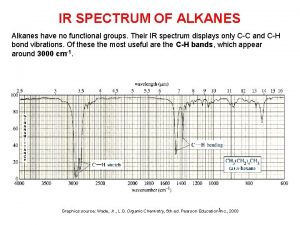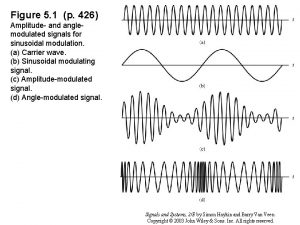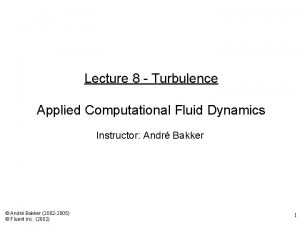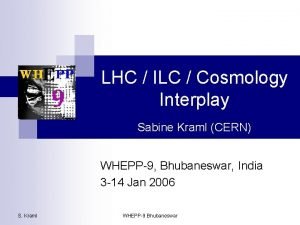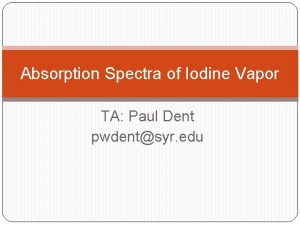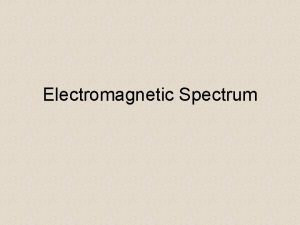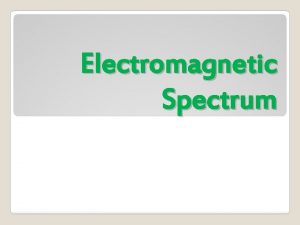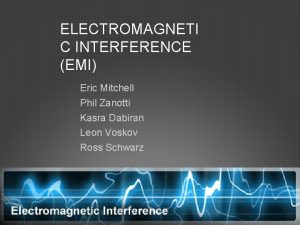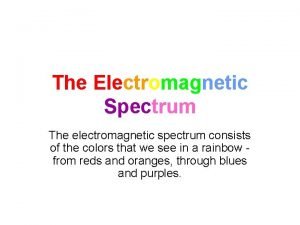ELECTROMAGNETI C SPECTRUM SC 7 P 10 1

















- Slides: 17

ELECTROMAGNETI C SPECTRUM SC. 7. P. 10. 1 Illustrate that the sun’s energy arrives as radiation with a wide range of wavelengths, including infrared, visible, and ultraviolet, and that white light is made up of a spectrum of many different colors.

ELECTROMAGNETI • The electromagnetic spectrum is more C SPECTRUM familiar to you than you might think. • The microwave you use to heat your food and the cell phones you use are part of the Electromagnetic Spectrum. • The light that our eyes can see is also part of the electromagnetic spectrum. This visible part of the electromagnetic spectrum consists of the colors that we see in a rainbow - from reds and oranges, through blues and purples. • Each of these colors actually corresponds to a different wavelength of light.

WHAT ARE ELECTROMAGNETIC WAVES? • Electromagnetic waves are formed when an electric field (shown as blue arrows) couples with a magnetic field (shown as red arrows).

ENERGY OF ELECTROMAGNETIC WAVES • The sun’s energy reaches Earth in the form of electromagnetic waves. • We call that type of energy: Radiation. • Radio waves, Microwaves, UV Rays and Gamma Rays are types of electromagnetic waves. They differ from each other in wavelength and frequency.

• WHAT SPEED DO THEY MOVE? A vacuum is a space that contains no air or gas. All electromagnetic waves travel at the same speed in a vacuum: the speed of light (3 x 108 m/s). • In other media (through matter), their speed is less.

• EM waves are typically described by any of the following two physical properties: the frequency and wavelength. Wavelength is the distance between one wave crest to the next. Frequency is the number of waves within a given period of time.

ELECTROMAGNETIC WAVES HAVE DIFFERENT WAVELENGTHS AND FREQUENCIES • Radiowaves have the longest wavelength and the lowest frequency. • Gamma Rays have the shortest wavelength and the highest frequency.

HOW DO THE WAVES FIT INTO THE ELECTROMAGNETIC SPECTRUM?

VIDEO: EM SPECTRUM

Try: Rabbits Mate In Very Unusual e. Xpensive Gardens How do I remember all this? meaning: Radio Microwaves Infra-Red Visible light Ultra-violet X-rays Gamma rays

RADIO WAVES Television stations use radio waves to broadcast their signals through the air just as broadcast radio stations do. Mobile phones Other uses of Radio Waves include Remote control toys GPS

MICROWAVES Microwave uses include finding planes in the sky and speeders on the ground (radar), sending a TV signal from a station to a broadcasting antenna (communication), and heating hot dogs (microwave ovens).

INFRARED Can you feel the heat? (Well, imagine that you can. ) You're in the infrared section of the electromagnetic spectrum. From people to planets, from incense candles to ice cubes, all objects give off infrared radiation. Infrared is used in night vision equipment when there is insufficient visible light to see. Weather satellites enable a trained analyst to determine • cloud heights and types, • land surface water temperatures, • and to locate ocean surface features Infrared radiation can be used to remove ice from the wings of aircraft.

THE VISIBLE SPECTRUM Electromagnetic waves you can see are called visible light Visible light waves have shorter wavelengths and higher frequencies than infrared rays. In the spectrum they go between Infrared waves and UV rays. ROY G BIV = Red, Orange, Yellow, Green, Blue, Indigo, and Violet. are the colors of the visible spectrum. Visible light is used for vision, photography, and illumination.

ULTRAVIOLET RADIATION • Electromagnetic waves with wavelengths just shorter than those of visible light • It stimulates the production of vitamin D in the skin • Too much exposure to ultraviolet rays can damage or kill living cells. • UV rays are used in sterilization and disinfection because they can kill germs and bacteria.

X-RAYS • THEY CANNOT BE SEEN OR FELT. X-RAYS MOSTLY PASS THROUGH SKIN, BUT THEY DO NOT EASILY PASS THROUGH BONE OR METAL. • X-RAYS ARE USED TO PRODUCE PHOTOGRAPHS OF BONES TO CHECK FOR DAMAGE SUCH AS FRACTURES. • THEY ARE ALSO USED IN AIRPORT SECURITY.

GAMMA RADIATION • THESE ARE THE MOST ENERGETIC WAVELENGTHS OF LIGHT, AND THEY HAVE THE SHORTEST WAVELENGTHS. • THEY ARE USED FOR: • CANCER TREATMENT • STERILIZE MEDICAL EQUIPMENT IN HOSPITALS • PASTEURIZE CERTAIN FOODS AND SPICES
 Absorption spectrum
Absorption spectrum Copper subshell configuration
Copper subshell configuration Columbia spectrum
Columbia spectrum Types of radiation in the electromagnetic spectrum
Types of radiation in the electromagnetic spectrum Ir spectrum of nitrile
Ir spectrum of nitrile Dsbfc waveform
Dsbfc waveform Electromagnetic spectrum foldable
Electromagnetic spectrum foldable Expanding strategic scope
Expanding strategic scope Spectrum packages
Spectrum packages Kolmogorov energy spectrum
Kolmogorov energy spectrum Dating definition relationship
Dating definition relationship Photoelectron spectrum of scandium
Photoelectron spectrum of scandium Electromagnetic wavelength formula
Electromagnetic wavelength formula Spectrum ilc 1002
Spectrum ilc 1002 Emission line spectrum
Emission line spectrum Stevenson and black 2007 inclusion spectrum
Stevenson and black 2007 inclusion spectrum Birge sponer plot
Birge sponer plot Bmi spectrum
Bmi spectrum




